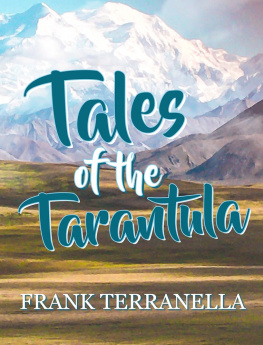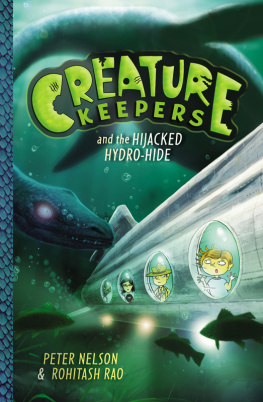Adams - Terrific Tarantula: A keepers Care Guide
Here you can read online Adams - Terrific Tarantula: A keepers Care Guide full text of the book (entire story) in english for free. Download pdf and epub, get meaning, cover and reviews about this ebook. year: 2015, genre: Children. Description of the work, (preface) as well as reviews are available. Best literature library LitArk.com created for fans of good reading and offers a wide selection of genres:
Romance novel
Science fiction
Adventure
Detective
Science
History
Home and family
Prose
Art
Politics
Computer
Non-fiction
Religion
Business
Children
Humor
Choose a favorite category and find really read worthwhile books. Enjoy immersion in the world of imagination, feel the emotions of the characters or learn something new for yourself, make an fascinating discovery.

Terrific Tarantula: A keepers Care Guide: summary, description and annotation
We offer to read an annotation, description, summary or preface (depends on what the author of the book "Terrific Tarantula: A keepers Care Guide" wrote himself). If you haven't found the necessary information about the book — write in the comments, we will try to find it.
Adams: author's other books
Who wrote Terrific Tarantula: A keepers Care Guide? Find out the surname, the name of the author of the book and a list of all author's works by series.
Terrific Tarantula: A keepers Care Guide — read online for free the complete book (whole text) full work
Below is the text of the book, divided by pages. System saving the place of the last page read, allows you to conveniently read the book "Terrific Tarantula: A keepers Care Guide" online for free, without having to search again every time where you left off. Put a bookmark, and you can go to the page where you finished reading at any time.
Font size:
Interval:
Bookmark:
Terrific Tarantula
A Keepers Care Guide
Vet Adams Copyright 2015
Baby Bearded Dragon Care
*
Amazing African Grey Parrot Care
*
Lovely Leopard Gecko Care
*
Buying a Puppy
*
Buying a Kitten
Terrific Tarantula
A Keepers Care Guide.
All rights reserved.
No part of this book may be copied or reproduced in any format, electronic, printed, microfilm or any other means, or incorporated into any other information retrieval system without the written permission of the author and copyright owner.
Disclaimer.
The author, copyright owner or publisher of this book cannot accept liability for any loss, injury, death, or damage of a Tarantula or Keeper by any user of this publication from the use of any information or recommendation or from any errors or omissions in this publication.
You have decided that you would like to keep a Tarantula as a pet, or maybe you already have one, if so, what a great choice as Tarantulas make terrific pets for the keen amateur and the seasoned expert.
This book is written specifically to guide you and to enhance your enjoyment and knowledge regarding the interesting life and daily requirements of the Terrific Tarantula.
Tarantulas of the Theraphosidae family- of which there are approximately 900 species- can be divided into three groups. The grouping depends upon their lifestyles in the wild.
1. The Free Ranging or Wandering Tarantulas.
This group makes temporary or semi-permanent habitats under rocks, leaf litter and even fallen branches. They will also use burrows that small creatures like rodents have excavated.
2. The Arboreal or Tree-Dwelling Tarantulas.
This group makes tube style webs amongst the branches of a tree, and this group very rarely comes down to ground level.
3. The Burrowing Tarantulas.
This group excavates their own burrows but will also improvise and utilize other ready-made small burrows. Other than when the mature male goes searching for a mate, they tend to inhabit the burrow for their entire lives.
Tarantulas are generally low maintenance and quite hardy pets, providing the correct temperature and humidity levels are maintained, and these exotic and virtually noiseless creatures that are inexpensive to feed and easy to house, make ideal pets for the caring and conscientious owner.
Most people purchase their tarantulas from Pet Shops, Specialist Breeders and even over the Internet. The Internet is possibly not the ideal medium to buy your spider from, unless the source is highly recommended, as it is always preferable to be able to view the spider and assess its health before purchasing.
Not all species of Theraphosidae Tarantula are suitable for novice keepers and this is where a specialist breeder or a good pet shop can come into its own and be able to suitably advice you. Many species are aggressive and very fast moving and therefore it stands to reason that the more docile, slower moving and relatively safer to handle spiders are the better species for the inexperienced and even the experienced keeper.
The increasing interest over the years, certainly since the early 1970s, has led to a proliferation of available species and with the increased knowledge of successful breeding techniques, most if not all tarantulas now purchased are Captive Bred thereby decreasing the pressure on wild caught specimens.
The following species of tarantula, of the genera Brachypelma, Avicularia, Eupalestrus and Chromatopelma are generally amongst the most highly recommended spiders for the novice and even the more experienced keepers.
These exotic tarantulas have amazing temperaments and exhibit genuinely docile behavior traits and these spiders would much rather flee than attack.

The original habitat of this species is in the savannas of Central America. Although not quite as colourful as some of its cousins, this spider exudes charms of its own. The tan and gold hairs that cover its body gives it a very appealing scruffy look.
However, like most other Central Americas Tarantulas, they do have Urticating Hairs (ficking hairs), which can be used for defense. They are however, not quick to flick them.
Being Burrowing Tarantulas their enclosure requires more land space than height. Upon growing to 3 inches, they do tend to be seen more on the surface than in their burrows.
Recommended humidity for these species is between 65-70%.
Recommended temperature for these species is between 70-85 degrees F (21-29 degrees C).
Crickets, small insects, mealworms, and the adults will even eat pinkies and fuzzy mice.
Males: 4 years. Females: 8 years.

The original habitat of this species is the harsh and dry climate, desert areas of Northern Venezuela, Paraguana. Extremely colourful with its vibrant orange abdomen and vivid blue metallic legs makes this species very popular amongst hobbyist.
However, these spiders can be a little skittish so novice nervous keepers could drop these tarantulas.
Being classed as Semi-Arboreal (Land & Tree dwelling) makes them a great display spider as they are active and they create wonderful silk web retreats, which can partially cover their enclosure.
Recommended humidity for these species is around 60%.
Recommended temperature for these species is 70-78 degrees F (21-26 degrees C).
Crickets, and Insects.
Males: 4 years. Females: 12 years.

The original habitat of this species is the Pacific Coast of Mexico. These beautiful vibrant red knees spiders are extremely popular amongst all levels of keepers.
However, a common problem associated with these spiders is the fact they are well known for Urticating Hairs (flicking hairs), which they are quick to use.
Being Burrowing and land dwelling, this species requires more land space than height.
Recommended humidity for these spiders is 50-60%.
Recommended temperature for these spiders is 70-80 degrees F (21-27 degrees C).
Crickets, insects, mealworms, and the adults will even eat pinkies, fuzzy mice and even lizards.
Males: 10 years. Females: 30 years.

The original habitat of this species is Lesser Antilles- Guadelupe, Dominica and Martinique in the Caribbean Sea. This technicolour spider makes an excellent display species, and highly recommended choice for beginners.
Font size:
Interval:
Bookmark:
Similar books «Terrific Tarantula: A keepers Care Guide»
Look at similar books to Terrific Tarantula: A keepers Care Guide. We have selected literature similar in name and meaning in the hope of providing readers with more options to find new, interesting, not yet read works.
Discussion, reviews of the book Terrific Tarantula: A keepers Care Guide and just readers' own opinions. Leave your comments, write what you think about the work, its meaning or the main characters. Specify what exactly you liked and what you didn't like, and why you think so.














